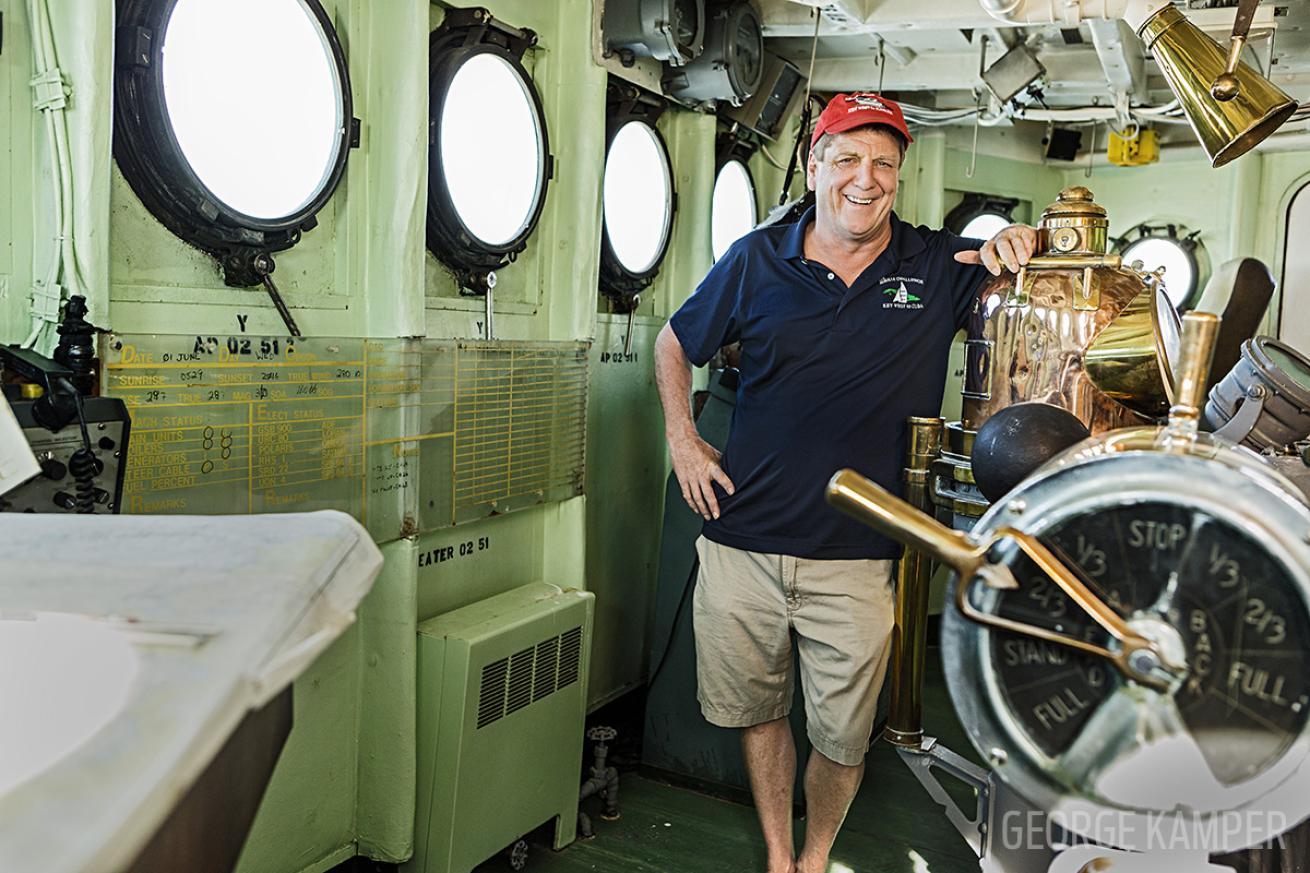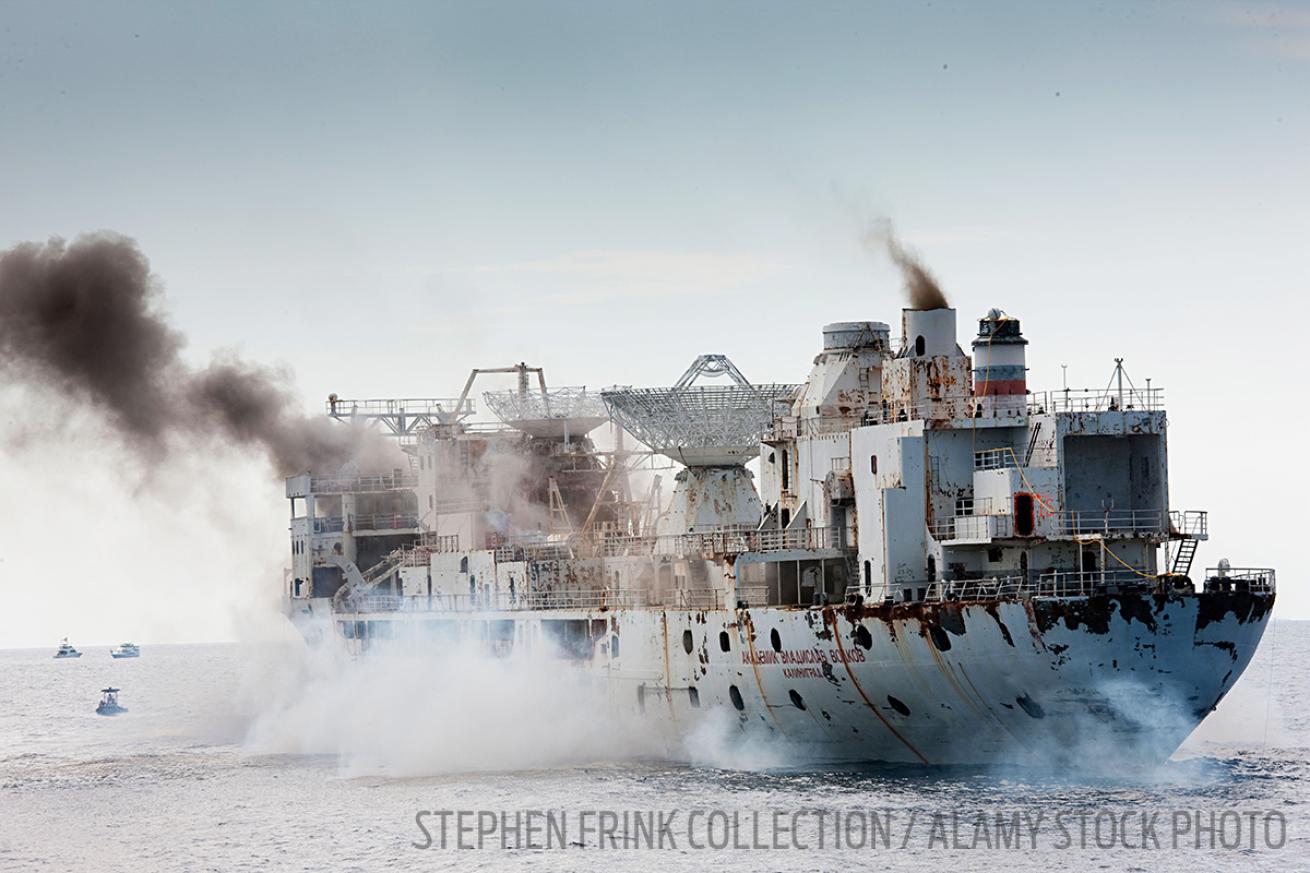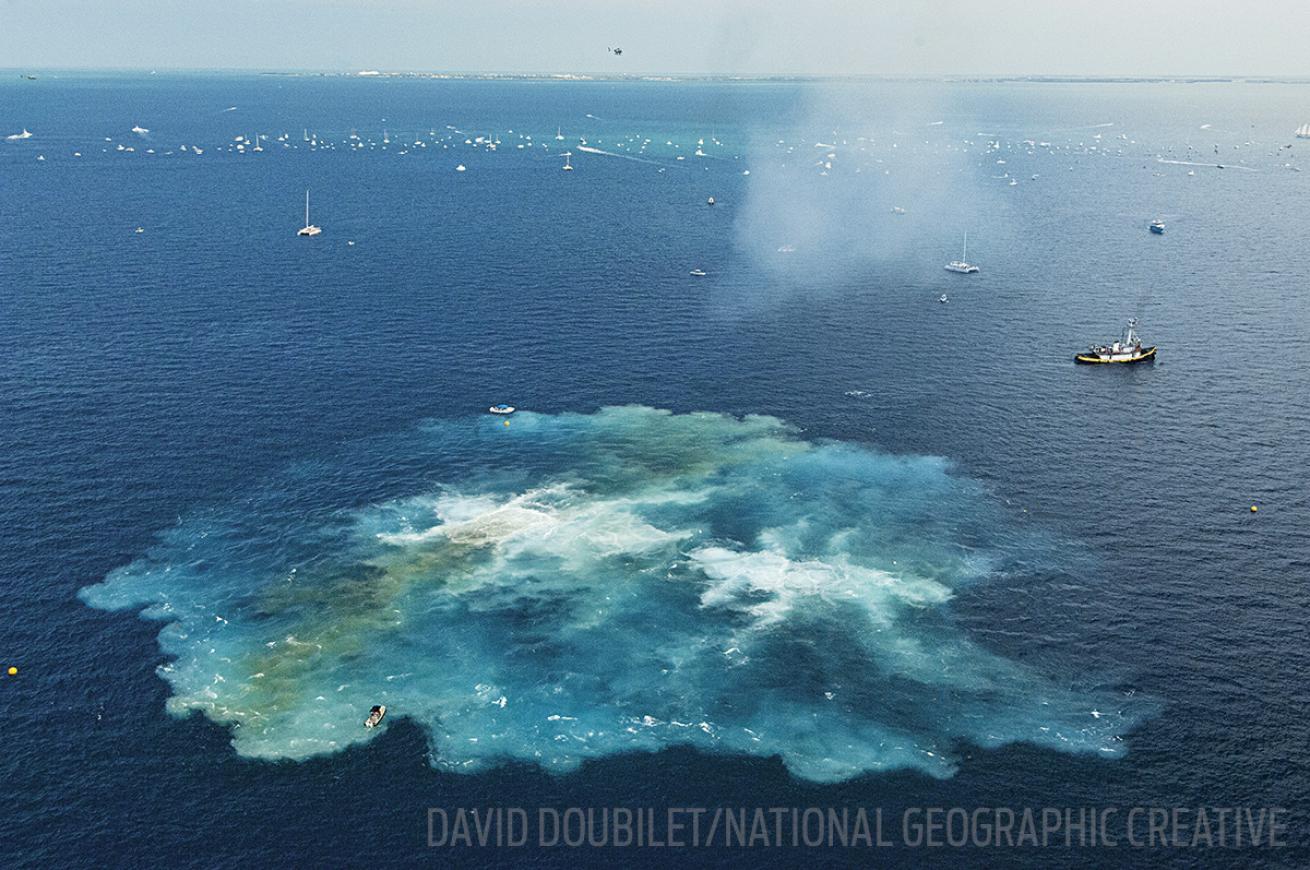Joe Weatherby Sinks Ships and Transforms them into Thriving Marine Ecosystems

George Kamper
Meet Artificial Reefs International President Joe Weatherby
Born: Avalon, N.J.
Lives: Key West, Florida
Day Job: President, Artificial Reefs International
Ships Sunk: Joe’s Tug, Key West; Vandenberg, Key West; Mohawk, Lee County, Florida; Annapolis, Gambier Island, BC
Moonlighting: Wreck Racing League, The Sinking World of Andreas Franke, Wicked Dolphin Sunken Barrel Rum
Stuntman: Sailed from Key West to Cuba in a catamaran seven times
Bucket List: Bikini Atoll, Antarctica, Zanzibar
THE MAN OF STEEL
Rabble-rouser, peacemaker, folksy charmer and irresistible force of nature, Joe Weatherby has a passion for sinking ships and saving our seas.
Weatherby is the P.T. Barnum of wreck-makers. Not only does the president of Artificial Reefs International transform retired military ships into thriving ecosystems, but he knows how to keep them alive in the minds of divers with creative events and promotions.
“People spend money to sink an artificial reef, and then they never advertise or market it or do anything with it,” says Weatherby. “That’s why we get into the art projects, the DPV racing, the underwater rum and all the crazy, wacko stuff that we’ve been doing all these years. It keeps people interested in coming down to our projects and having a little fun — and the results speak for themselves.”
Successful sinking projects such as Key West’s Vandenberg, Mohawk off Fort Myers, Florida, and Annapolis in British Columbia are testament to Weatherby’s prowess at saving historic vessels by preparing them with diver access in mind, and his success at preserving historical elements such as propellers, guns and radar dishes.
“Fish can’t tell the difference between a ship or a shopping cart, but people can,” says the longtime resident of Key West. “People won’t come to Florida from England to go diving on shopping carts, but they will to dive on a cool, famous ship. If you’re not going to make it interesting, you might as well be sinking shopping carts.”
Since his introduction to the artificial-reef-making process from the ’80s through the hard-won 13-year Vandenberg project, Weatherby has been steadily improving his craft and expanding his scope with one goal in mind. “My job is to make sure that there’s lots of fish, lots of recreational fishing, and lots of scuba diving,” he says. “I see artificial reefs as proactive environmentalism. I drank the Kool-Aid, man. I’m a true believer.”
Part rabble-rouser, part peacemaker and all-around motivating force, Weatherby’s progress from dive-boat captain to world-class reefer hasn’t been nearly as direct as the path the ships he sinks take to the bottom.
DESTINED TO DIVE
Fueled by TV heroes such as Jacques Cousteau and Mike Nelson, Weatherby dreamed of discovering lost shipwrecks as a boy, but his dad wouldn’t spring for scuba lessons.
“I moved to Key West in October 1985, about five months after Mel Fisher found the mother lode. I was in my early 20s, so this was the stuff of wild imagination, and I landed right in it,” says Weatherby. “The first thing I did was buy 50-dollars’ worth of scuba-diving equipment. It was an old Conshelf brass regulator, a steel 72 with a K valve, and a backpack with traditional webbing — no horse collar though.”
The transaction was followed by his first breath underwater, in the pool at the Key West Ocean Key House.
“I remember putting my face in the water, but I just couldn’t make myself take a breath out of the regulator,” he recalls. “When I finally breathed in, I swam to the bottom, and I’ve been at the bottom of the pool ever since. Never looked back.”
Most recently, Weatherby contributed to the sinking of the 370-foot Annapolis off Gambier Island in British Columbia, Canada. There’s always a next project in the works for Weatherby, but he isn’t a “sink ’em and leave ’em” type. His current endeavors revolve around creating continued interest — and tourism traffic — for his wrecks in novel ways.
THE GREATEST SHOW BENEATH THE SEA
According to Weatherby, “sink it and they will come” is true only for fish.
To maximize massive investments, artificial reefs must be marketed and promoted after they are created to generate sustained economic benefit.
“I firmly believe that artificial reefs need to be looked at as pure economic development,” he says. “My motivation is to help the oceans and promote tourism.”
To continue the momentum created by the well-publicized sinking events for Vandenberg and Mohawk, Weatherby and his cohorts got creative. The Wreck Racing League, which began with the Vandenberg Underwater Grand Prix in 2009, has hosted DPV races across Florida and in Italy, and has spawned a moving annual event at Florida’s Weeki Wachee Springs to benefit wounded veterans learning adaptive scuba.
The Sinking World, a series of installations on artificial reefs by Austrian artist Andreas Franke, has adorned Vandenberg, Mohawk and Stavronikita in Barbados; new installations are planned for a decommissioned oil-drilling rig in the Gulf of Mexico and to-be-determined wrecks in North Carolina.
And then there’s Weatherby’s most over-the-top stunt to date: sinking barrels on wrecks to make rum.
“You’ve heard of the Angel’s Share, or the Devil’s Cut. It’s the product that soaks into the barrel while they’re aging whiskey,” he says. “Well, this is Poseidon’s Part. We take used rum-aging barrels, fill them up with distilled water, swim them down to the wreck, and hide them in there for a little while. The pressure squeezes the residual rum out of the wood and into solution in the distilled water in the barrel. Then, we bring it up and make Vandenberg- and Mohawk-flavored rums. We worked with Fort Myers’ Mike Campbell and Wicked Dolphin Distillery and made hundreds of bottles. People lined up around the block, and they sold it all in 45 minutes for the benefit of artificial-reef programs.”
“Anybody who works with Joe on a project should know that it’s going to be successful and that it’s going to be a lot of fun,” says frequent conspirator Sirak. “He negotiates relationships and friendships seamlessly, and brings people in just by his quick wit and engaging personality. It makes you want to do whatever he’s doing.”
“A typical artificial-reef project is run by a fisheries biologist and a state environmental regulator. These guys are very good at doing artificial reefs, and they’re also very necessary to make sure they’re done right,” Weatherby says. “But you know who’s missing? A salesman. That’s what these things need to be more successful. No other business would spend money on an asset and then just not market it.”
RETURN ON INVESTMENT
The future of the reef is metallic, in Weatherby’s mind. Besides the proven economic benefits, reefing ships offers hope for struggling marine environments around the world.
“There’s no good news coming from the reef, man,” he says. “This isn’t theory anymore. The jury is not out. The results are in. We’ve been studying artificial reefs for 50 years. It’s time for more of them.”
Weatherby’s relationships with environmental groups such as the Florida Keys National Marine Sanctuary are helping to encourage more research on the ecological benefits of artificial reefs. Recreational divers offer anecdotal evidence every time they spot a whale shark on Mohawk, or a manta ray on Vandenberg.
“Every single bit of research that I’ve seen says that artificial reefs are good medicine for the ocean, especially properly conceived ones,” Weatherby explains. “I think that if people can be exposed to marine life in this kind of way, it’s something that impacts them and changes their thinking. That moment when the light comes on. I see that look on people’s faces — that’s what we’re going for.”
HISTORY OF ARTIFICIAL REEFS INTERNATIONAL
Artificial Reefs International was launched more than 30 years ago to create a cross-functional team approach to sinking ships. The team has handled project design, operations management, fundraising, environmental remediation, media relations, marketing, deployment and risk management for landmark ventures, including Vandenberg, Mohawk and Annapolis, since its founding. In addition, ARI has received a number of awards, including the Society of American Travel Writers Phoenix Award and the 2013 Region 13 Edward R. Murrow Award from the Radio Television Digital News Association. Most recently, ARI launched its nonprofit arm — Artificial Reefs International Preservation Trust. For more information, go to [arireefs.com](](https://arireefs.com/).
EXTRA KEYS WRECK DIVES
A Florida Keys local for more than 30 years, Joe Weatherby says Key West’s best-kept secret of interest to divers is the Coast Guard Cutter Ingham. Now a floating museum and National Historic Landmark, the Ingham is a sister ship to Keys wrecks Bibb and Duane, and offers an unparalleled dry-run preview for divers who want to challenge those renowned Key Largo artificial reefs. Plus, it offers experienced fans of those ships a chance at a whole new perspective on them. For information, go to uscgcingham.org.

Stephen Frink Collection/Alamy
BOMBS AWAY
Explosives heralded Vandy’s journey to the bottom of Key West to become an artificial reef in May 27, 2009.

David Doubilet/National Geographic Creative
DOWN IT GOES
The sinking of the Vandenberg as an artificial Reef in Key West created a temporary mirage of its own atoll.










